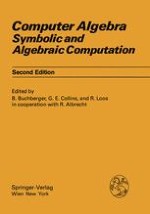this gap. In sixteen survey articles the most important theoretical results, algorithms and software methods of computer algebra are covered, together with systematic references to literature. In addition, some new results are presented. Thus the volume should be a valuable source for obtaining a first impression of computer algebra, as well as for preparing a computer algebra course or for complementary reading. The preparation of some papers contained in this volume has been supported by grants from the Austrian "Fonds zur Forderung der wissenschaftlichen For schung" (Project No. 3877), the Austrian Ministry of Science and Research (Department 12, Dr. S. Hollinger), the United States National Science Foundation (Grant MCS-8009357) and the Deutsche Forschungsgemeinschaft (Lo-23 1-2). The work on the volume was greatly facilitated by the opportunity for the editors to stay as visitors at the Department of Computer and Information Sciences, University of Delaware, at the General Electric Company Research and Development Center, Schenectady, N. Y. , and at the Mathematical Sciences Department, Rensselaer Polytechnic Institute, Troy, N. Y. , respectively. Our thanks go to all these institutions. The patient and experienced guidance and collaboration of the Springer-Verlag Wien during all the stages of production are warmly appreciated. The editors of the Cooperative editor of Supplementum Computing B. Buchberger R. Albrecht G. Collins R. Loos Contents Loos, R. : Introduction. . . . . . . . . . . . . . . . . . . . . . . . . . 1 Buchberger, B. , Loos, R. : Algebraic Simplification . . . . . . . . . . 11 Neubiiser, J. : Computing with Groups and Their Character Tables. 45 Norman, A. C. : Integration in Finite Terms. . . . . . . . . . . . . .
